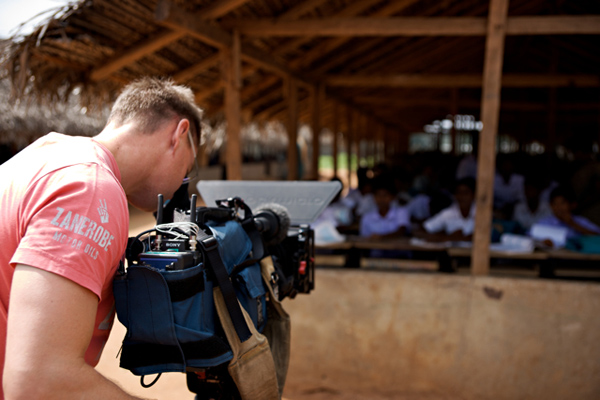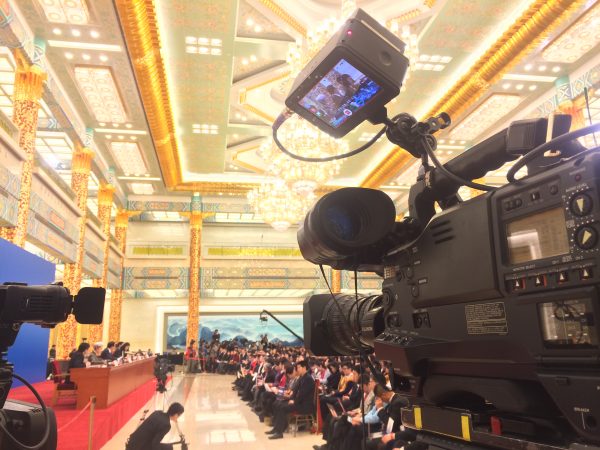An opinion by Matt Allard:

It’s a difficult time to be employed in the news industry. Whether you’re a cameraman, photographer, editor, producer, reporter or do any of the other countless jobs in our industry you will have been personally affected by cuts or know someone who has. Many of the people I greatly admire and respect have also left staff positions by choice and countless people I used to work with in Australia are now out of jobs. Ironically, at the ACS (Australian Cinematography Society) Awards held last week, all the winners in the News and current affairs categories were freelancers and not staff. This is the first time this has ever happened. It tells me a lot about the poor state of our industry.
Logically, you would expect there to be more work available now than there has ever been. Surely, with more content being required, more people are needed to create it. So why is the news industry making massive cuts and laying off staff in record numbers?
People’s lives have become increasingly busy and they don’t have time to sit down and watch whole news bulletins or read a newspaper. Unfortunately, it is society that dictates in a lot of ways what we do and how we do it. In the old days your job probably finished at 5pm and you were home by 5.30. You lived closer to where you worked and your wife probably didn’t have to go to work.
Now, while this is a bit of a stereotypical example, it is an insight into why the media landscape has changed and traditional models no longer work. If you don’t have an viewer at home to watch your 6pm bulletin or you a reader sitting down at a breakfast table with a newspaper, how is your business model going to succeed?
The majority of potential viewers are now getting their content online and this is especially true of news content. Whether this be on an iPad, smart phone or their home computer, viewers no longer need to sit down and watch broadcast television on their TV or read a physical newspaper. There still are those people who watch free-to-air television but they don’t tend to be in the core 15-35 demographic, where most of the advertising dollars are aimed. Traditional media organizations such as commercial television networks are clinging on to the old business models and squeezing out every last penny they can.

TV news and current affairs used to be edgy and in-depth, and I think the fact that programmes have moved away from these values is part and parcel of the continuing demise. A tongue-in-cheek tweet I saw the other day said: “I watch TV news to see what happened on Twitter yesterday.”
Traditional 6pm TV broadcasts used to work because they were the only way, apart from radio, to find out what had happened during the day. For newspapers, you had to wait until the next day to find out. The internet and particularly social media have taken away the edge that TV and newspapers used to have. Sure, 140 characters in a tweet and a small video clip on Facebook can’t give you in-depth coverage like a TV report or newspaper article could but they don’t need to. Social media has dramatically affected not only traditional local news bulletins but 24 hour news as well. A 24 hour news channel used to have a great advantage in breaking news situations as it could deliver you the information first but that is not the case anymore. Why tune in to see some reporter telling you about what is going on from a live position when you can find out on Twitter earlier? Why wait to see pictures or a news report when I can already see video of something on Facebook? These are the questions our industry is facing and we need to come up with answers.
The problem with social media is that most of it is citizen journalism and the facts can’t be verified; nor can you be completely sure it is not being used to promote an agenda. This is where proper news organisations should have the advantage, but they don’t seem to have moved with the times. If you look at a lot of international 24 hour news networks’ websites they are clunky, hard to use and seem to be there for the sake of having a website because people are going online for news more and more. To be fair, they have improved in recent years, but are they really focusing their attention enough on developing this platform? If you look at the staffing and budgets for online compared to normal 24 hour news coverage, there is a staggering difference.
If you want to compete in today’s online age you need to offer the customer something different. 24 hour news will never be able to compete with social media for speed. What they can provide, which social media can’t, is in-depth analysis of what is going on. Certainly, it is important to be first, but if your competition – social media – is beating you to the punch, you need to do something differently. For example, making sure somebody can find out quickly what is going on from your website and get access to in-depth analysis via a story. It’s the equivalent of reading a newspaper headline and then working out if you want to know more.
Despite the rapid advances in technology, the overall standard of TV news camerawork, editing and reporting doesn’t seem to have gone along for the ride. Does the audience really care about quality? I think it does. You don’t have to be in the industry to work out if something is good or not. You don’t keep watching a TV show or a movie if it’s bad – so why should TV news be any different? Unfortunately, in 24 hour news the live cross has come to dominate content. While in theory there is nothing wrong with this, it is often done in a location where you can’t see what is happening because of the technology needed to transmit, or ends up with the reporter simply standing in the same spot for hours on end waiting to tell you that nothing has happened since the last time they spoke. Instead of covering the story, reporters and cameramen are getting tied to live positions.Twenty-four hour news is a hungry beast that needs to be fed at all times and unfortunately live crosses are like a Big Mac, with stories reduced to being the side order of fries.
But in 2013 PricewaterhouseCoopers conducted a study that showed for the first time more money was being spent on internet advertising than on free-to-air TV ads. This is a huge statistic and one that the free-to-air TV networks in particular don’t seem to have to cottoned onto. If your main source of revenue is from advertising and the advertisers are shifting those dollars away from TV and into online media, you should know something needs to change. If you run an ice-cream parlour and suddenly most customers stop eating strawberry ice-cream and start eating chocolate, why would you continue to buy large amounts of strawberry? Nightly news bulletins with a good reputation can bring in a much larger audience by drawing viewers in and keeping them through primetime. In a lot of ways, news is like the warm-up act for the main performance. If the viewers tune in and then stay on the same channel you are keeping that audience in the prime advertising time slots. That said, the TV business is expensive. By the time you figure in equipment costs, satellite feeds, salaries and the myriad of other associated costs, it’s hard to imagine turning a profit unless you have a strong viewership.
Hunter S. Thompson once wrote: “The TV business is uglier than most things. It is normally perceived as some kind of cruel and shallow money trench through the heart of the journalism industry, a long plastic hallway where thieves and pimps run free and good men die like dogs, for no good reason.” This is the problem. Because TV news is expensive to produce, if people aren’t watching or the station is doing badly in other areas, the first to go are normally the news people. Just this week, Network Ten Australia announced that 150 jobs in news would be cut. Less than four years ago the network was running a combination of news and current affairs programs for two hours a night and had employed large numbers of new staff. In 2012, 100 staff members were let go and now another 150 have lost their jobs. I don’t think this is all to do with viewers moving to online content, but that is certainly a part of it. Ten has had a rather chequered history over the last 20 years of program successes and failures in the news arena. Across the globe, networks like CNN, BBC and newspapers like the Chicago Sun-Times have seen lay
offs and staff reductions.
So what is the future for people in our industry? It doesn’t look good. I don’t see the trend of staff job losses changing any time soon. As content creators, it’s important for us to keep the standards high and to find new and interesting ways to tell our stories before it becomes too late.
This week I spoke to award-winning journalist Aela Callan, who is currently undertaking the John S. Knight Fellowship at Stanford University about the current state of broadcast media, what the media is doing wrong and why social media is something we should use to our advantage instead of worrying about it taking our jobs. Watch below:
Journalism And Social Media from Matthew Allard ACS on Vimeo.





